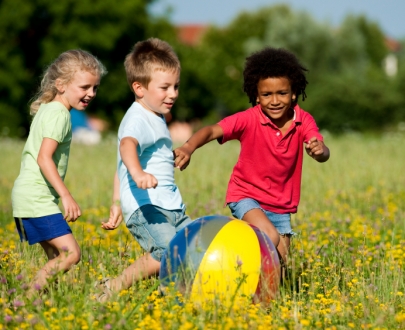 Did you know that children are spending less time in unstructured play – especially outdoors and in natural settings – than at any other time in history?[1]
Did you know that children are spending less time in unstructured play – especially outdoors and in natural settings – than at any other time in history?[1]
Outdoor play is important for children’s well-being and growth. Research[2] tells us that it is through play that children learn and develop and the outdoors provides a unique setting that gives children different play opportunities than those available indoors. Children learn valuable lessons and practice new skills when they play outdoors.
5 Benefits of Outdoor Play:
1. Outdoor Play Provides Challenge
Outdoor play gives children the chance to experience new challenges and risks. By experiencing challenges, a child builds confidence as they learn how to overcome these challenges. Experiencing risk, by trying new things and overcoming fears, helps children learn to spot risks and make decisions about risky situations. Challenging outdoor play helps children feel secure in their abilities, which reduces their feelings of fear and anxiety.
2. Time in Nature is Calming
Playing outside in a natural setting, like a park or a forest, can be a calming experience for your child. Contact with nature has been shown to reduce children’s feelings of stress. Time spent playing in nature can help your child to feel less anxious and more secure and calm.
3. Outdoor Play is Creative
Outdoor play gives children the opportunity to be creative. Outdoor materials like sand and dirt can be moved and changed by children to build their own creations. This allows children to see how their actions create change. While playing outdoors, children often participate in dramatic play by pretending to be different people and acting out different events. This allows children to try out social situations.
4. Outdoor Play is Social
Outdoor play areas are children’s spaces to play with each other. Children are able to play with other children with less control from adults. This creates opportunities for children to practice getting along with others.
5. Outdoor Play Increases Attention
After playing outdoors in nature, children may be able to focus better and pay more attention to tasks. Spending time in nature has been linked to increased attention. Taking a break to play outdoors can help children to be more alert and engaged.
In 2013, the David Suzuki Foundation conducted a youth survey asking about habits and experiences outdoors. 70% said they spent less than an hour a day outside, usually in transit to somewhere else.
Retired research professor and author Peter Gray, in his book Free to Learn (2013), describes the changes over the last 50 years on children's free play. He writes that since the 1960's, adult-directed activities (homework, sports, classes) and an increase in safety concerns has resulted in a decline in the amount of time children spend in unstructured play.
Sources for this resource include:
- Faber Taylor, A., Kuo, F. E., & Sullivan, W.C. (2001). Coping with ADD: The surprising connection to green play settings. Environment and Behaviour, 33, 54-77.
- Faber Taylor, A. & Kuo, F. E. (2011). Could exposure to everyday green spaces help treat ADHD? Evidence from children’s play settings. Applied Psychology: Health and Well-Being, 3, 281-303.
- Fjørtoft, I. (2001). The natural environment as a playground for children: The impact of outdoor play activities in pre-primary school children. Early Childhood Education Journal, 29, 111-117.
- Herrington, S. & Lesmeister, C. (2006). The design of landscapes at child-care centres: Seven Cs. Landscape Research, 31, 63-82.
- Little, H. & Wyver, S. (2008). Outdoor play: Does avoiding the risks reduce the benefits? Australian Journal of Early Childhood, 33, 33-40.
- Sandseter, E. B. H. (2011). Children’s risky play from an evolutionary perspective: The anti-phobic effects of thrilling experiences. Evolutionary Psychology, 9, 257-284.
- Stephenson, A. (2002). Opening up the outdoors: Exploring the relationship between the indoor and outdoor environments of a centre. European Early Childhood Education Research Journal, 10, 29-38.
- Tovey, H. (2007). Playing outdoors: Spaces and places, risk and challenge. Maidenhead: Open University Press.
- Wells, N. M. & Evans, G. (2003). Nearby nature: A buffer of life stress among rural children. Environment and Behavior, 35, 311-330.
- Wells, N. M. (2000). At home with nature: Effects of “greenness” on children’s cognitive functioning. Environment and Behavior, 32, 775-795.